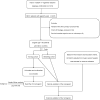A nomogram for predicting prognosis for young cervical neuroendocrine carcinoma: A SEER-based study and external validation
- PMID: 39959660
- PMCID: PMC11827425
- DOI: 10.3389/fonc.2025.1463422
A nomogram for predicting prognosis for young cervical neuroendocrine carcinoma: A SEER-based study and external validation
Abstract
Background: Neuroendocrine carcinoma of the cervix (NECC) is a rare and highly aggressive subtype of cervical carcinomas with poor prognosis. NECC tends to occur in young age which could severely impair mental and physical health of young patients. Therefore, this study aims to develop an individualized prognostic nomogram for young NECC patients.
Methods: 360 young (≤45 years old) NECC patients were retrospectively selected from the Surveillance, Epidemiology and End Results (SEER) database and were randomly located to a training cohort and an internal validation cohort in a ratio of 7:3. Data from Fujian Cancer Hospital was used as an external validation cohort. Independent prognostic factors were identified by univariate and multivariate Cox regression analysis, and a prognostic nomogram for young NECC was developed. The predictive accuracy and clinical utility of the nomogram were assessed by area under the time-dependent receiver operating characteristic (timeROC) curve (AUC), the concordance index (C-index), calibration plots, and decision curve analysis (DCA). Finally, a simplified scoring system for clinical use was constructed by dividing patients into high-risk and low-risk groups.
Results: Pathological type, FIGO stage, and surgery were independent risk factors by univariate and multivariate analysis (P < 0.05). The prognostic nomogram consisting of the above three independent risk factors had high accuracy. The AUC values of 5-year overall survival (OS) in the training, internal validation, and external validation cohorts were 0.805, 0.798 and 0.872, respectively. The prognostic nomogram also presented with good C-index and calibration plots. The DCA curve further confirmed that the nomogram had a high clinical net benefit. According to the median prognostic index (median PI=18.6), all patients were categorized into high-risk group and low-risk group. The 5-year OS of the high-risk NECC group was significantly worse than that of the low-risk group among three cohorts (P<0.05).
Conclusions: Pathological type, FIGO stage, and surgery were identified as independent prognostic risk factors for young NECC patients. Based on the nomogram, gynecologic oncologists can accurately and easily predict the prognosis of young NECC and provide scientific guidance for individualized treatment.
Keywords: SEER database; external validation; neuroendocrine carcinoma of the cervix; prognostic nomogram; youth.
Copyright © 2025 Xie, Yu, Lin, Deng, Liu and Sun.
Conflict of interest statement
The authors declare that the research was conducted in the absence of any commercial or financial relationships that could be construed as a potential conflict of interest.
Figures






Similar articles
-
Prognostic model for survival in patients with neuroendocrine carcinomas of the cervix: SEER database analysis and a single-center retrospective study.PLoS One. 2024 Jan 5;19(1):e0296446. doi: 10.1371/journal.pone.0296446. eCollection 2024. PLoS One. 2024. PMID: 38181016 Free PMC article.
-
Competing risk nomogram and risk classification system for evaluating overall and cancer-specific survival in neuroendocrine carcinoma of the cervix: a population-based retrospective study.J Endocrinol Invest. 2024 Jun;47(6):1545-1557. doi: 10.1007/s40618-023-02261-7. Epub 2024 Jan 3. J Endocrinol Invest. 2024. PMID: 38170396 Free PMC article.
-
Construction and validation of the prognostic model for patients with neuroendocrine cervical carcinoma: a competing risk nomogram analysis.BMC Cancer. 2022 Jan 3;22(1):4. doi: 10.1186/s12885-021-09104-9. BMC Cancer. 2022. PMID: 34980030 Free PMC article.
-
Causes of death analysis and the prognostic model construction in neuroendocrine carcinoma of the cervix: A SEER-based study.Cancer Med. 2024 Aug;13(15):e70066. doi: 10.1002/cam4.70066. Cancer Med. 2024. PMID: 39118477 Free PMC article.
-
OHCCPredictor: an online risk stratification model for predicting survival duration of older patients with hepatocellular carcinoma.Hepatol Int. 2024 Apr;18(2):550-567. doi: 10.1007/s12072-023-10516-x. Epub 2023 Apr 17. Hepatol Int. 2024. PMID: 37067674 Free PMC article.
References
-
- Zhang X, Li M, Zhang G, Shen D. Neuroendocrine carcinoma of the cervix: A comprehensive clinicopathologic study and literature review. Gynecology Obstetrics Clin Med. (2023) 3:163–9. doi: 10.1016/j.gocm.2023.07.003 - DOI
-
- Carroll MR, Ramalingam P, Salvo G, Fujimoto J, Solis Soto LM, Phoolcharoen N, et al. . Evaluation of PARP and PDL-1 as potential therapeutic targets for women with high-grade neuroendocrine carcinomas of the cervix. Int J Gynecol Cancer. (2020) 30:1303–7. doi: 10.1136/ijgc-2020-001649 - DOI - PMC - PubMed
LinkOut - more resources
Full Text Sources
Research Materials
Miscellaneous

